Review:
According To The Kinsey Reports
A noisy revolution in social science and popular culture
Jim Burroway
January 3, 2008
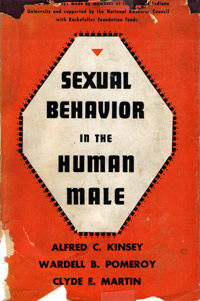 On January 5, 1948, W.B Saunders, a serious, well-regarded publisher of medical textbooks, released Alfred C. Kinsey’s Sexual Behavior In the Human Male. Co-written with fellow researchers Wardell B. Pomeroy and Clyde E. Martin from Kinsey’s Institute for Sex Research at Indiana University, the book was typical for the W.B. Saunders catalogue, weighing in at more than 800 pages and written with a dry, scientific style with mounds of statistical tables, charts and figures. All of this made Sexual Behavior In the Human Male a highly unlikely candidate for becoming a national best-seller.
On January 5, 1948, W.B Saunders, a serious, well-regarded publisher of medical textbooks, released Alfred C. Kinsey’s Sexual Behavior In the Human Male. Co-written with fellow researchers Wardell B. Pomeroy and Clyde E. Martin from Kinsey’s Institute for Sex Research at Indiana University, the book was typical for the W.B. Saunders catalogue, weighing in at more than 800 pages and written with a dry, scientific style with mounds of statistical tables, charts and figures. All of this made Sexual Behavior In the Human Male a highly unlikely candidate for becoming a national best-seller.
But in the optimistic post-war years, Sexual Behavior In the Human Male quickly became a massive success, selling more than 250,000. This surprised everyone at that staid Philadelphia publishing house, who were more accustomed to the idea that 5,000 copies would be a respectable run for such an academic volume. Instead, they had to keep two presses running constantly to keep up with demand. Americans had never before had access to this kind of detailed information on sexuality, and they were both scandalized and fascinated by the statistics and detailed descriptions of their fellow Americans’ sexual practices and fantasies.
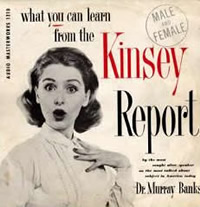 Sexual Behavior In the Human Male was the result of a very large, wide-ranging survey of sexual attitudes and practices that Kinsey and his colleagues began in 1938. By the time Sexual Behavior In the Human Male was published, they had collected more than 12,000 sexual case histories covering more than 500 items. Kinsey followed his 1948 volume with Sexual Behavior In the Human Female in 1953, this time with Paul H. Gebhard joining the previous co-authors. At 842 pages, it too became a best seller. W.P. Saunders learned their lesson from their previous volume, this time ordering an initial printing of 250,000 copies of the female volumed amid tight security, lest any details leak out from the eagerly anticipated book. Together, these two books have become popularly known as the Kinsey Reports.
Sexual Behavior In the Human Male was the result of a very large, wide-ranging survey of sexual attitudes and practices that Kinsey and his colleagues began in 1938. By the time Sexual Behavior In the Human Male was published, they had collected more than 12,000 sexual case histories covering more than 500 items. Kinsey followed his 1948 volume with Sexual Behavior In the Human Female in 1953, this time with Paul H. Gebhard joining the previous co-authors. At 842 pages, it too became a best seller. W.P. Saunders learned their lesson from their previous volume, this time ordering an initial printing of 250,000 copies of the female volumed amid tight security, lest any details leak out from the eagerly anticipated book. Together, these two books have become popularly known as the Kinsey Reports.
It's virtually impossible to overstate the impact the Kinsey Reports had on the American public. Most Americans assumed that nearly everyone conformed to what was considered traditional sexual morals, and that those who didn’t were an exceptionally tiny, deviant minority. And academics weren’t much better informed either. Before 1948, discussions of sexuality were mostly limited to moralists and ethicists, basing their work on assumptions and impressions of what they thought was going on behind closed doors. And most of these discussions took place in staid textbooks, university lecture halls, and the occasional marriage manual filled with inaccurate information on sexuality.
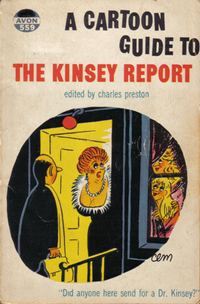 Kinsey changed all that. Instead of moral propositions and academic conjectures of what constituted conventional behavior, Kinsey and his colleagues were able to provide statistical evidence for a dizzying array of sexual practices, behaviors, fantasies and attitudes. And as the noted sex researcher Dr. John H. Gagnon pointed out, the fact that all of this was described using hard numbers made the Kinsey Reports a cultural phenomenon:
Kinsey changed all that. Instead of moral propositions and academic conjectures of what constituted conventional behavior, Kinsey and his colleagues were able to provide statistical evidence for a dizzying array of sexual practices, behaviors, fantasies and attitudes. And as the noted sex researcher Dr. John H. Gagnon pointed out, the fact that all of this was described using hard numbers made the Kinsey Reports a cultural phenomenon:
In the extensive print responses to the Kinsey volumes in the 1940s and 1950s, it was the “how many” and “how often” of various sexual practices that occupied central stage. Facts about how many women were virgins before marriage, how many women and men were adulterers after marriage, how many persons were ever homosexual, and how many were masturbators were fused with the facts about how many orgasms were associated with these practices. In a very short period, these facts, though already the target of respectful, but serious scientific criticism, became the sex numbers for American society. The dilemma for subsequent researchers, educators, policy makers, science writers and news readers was that there were no other comparable numbers for nearly four decades.1
Kinsey’s massive compendium of “how many” and “how often” exploded several myths and astonished the American publish with reports of what their neighbors were doing. Kinsey reported that masturbation was almost universal (almost 92% of men did it2), that oral sex was very common (70% of couples did it3), that premarital sex was widespread,4 and that between a third and half of all married men had had at least one extramarital affair.5
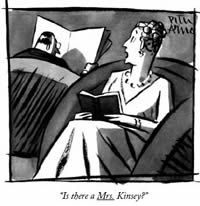 Almost overnight, Sexual Response in the Human Male made the quiet midwestern college professor a national celebrity, and his name became a code word for all things sexual or risqué. Kinsey quickly earned a place in American popular culture:
Almost overnight, Sexual Response in the Human Male made the quiet midwestern college professor a national celebrity, and his name became a code word for all things sexual or risqué. Kinsey quickly earned a place in American popular culture:
According to the Kinsey report
ev‘ry average man you know
much prefers to play his favorite sport
when the temperature is low.
— Cole Porter, “Too Darn Hot,” from the 1948 musical “Kiss Me Kate”
The Popular Lore of “Ten Percent”
Americans became obsessed with the facts and figures of the Kinsey reports, and probably the most controversial figure is his famous “ten percent” statistic — the one that claims that 10% of the population is gay. In fact, his findings weren’t so clean and straightforward, partly because Kinsey himself disapproved of using clean, dichotomous categories like homosexual or heterosexual to describe individuals. His only concern was sexual behavior, the only measure that he felt was reliable. To help define this behavior, Kinsey created what has become known as the Kinsey scale, which ranked sexual behavior from 0 to 6, with 0 being completely heterosexual and 6 completely homosexual. X’s were assigned to those who were asexual or sexually inexperienced.
In Sexual Behavior in the Human Male, Kinsey reported that 37% of the men had at least one homosexual experience.6 As for the famous “ten percent” figure, it was only one of several statistics that Kinsey cited on the incidence of homosexuality:
13 per cent of the population has more of the homosexual than the heterosexual (i.e., rates 4-6) for at least three years between the ages of 16 and 55. This is one in eight of the white male population.
10 per cent of the males are more or less exclusively homosexual (i.e., rate 5 or 6) for at least three years between the ages of 16 and 55. This is one male in ten in the white male population.
8 per cent of the males are exclusively homosexual (i.e., rate a 6) for at least three years between the ages of 16 and 55. This is one male in every 13.
4 per cent of the white males are exclusively homosexual throughout their lives after the onset of adolescence (Table 150, Figure 168).7 [Emphases in the original]
In Sexual Behavior in the Human Female, 7% of single women aged 20-35, and 4% of previously married women in the same age group were rated at Kinsey 3.8 About 2 to 6% of women were more or less exclusively homosexual.9
The Conservative Backlash
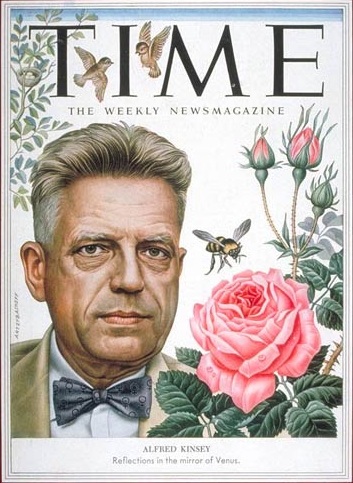 While the Kinsey Reports enjoyed unprecedented popular acclaim, they also drew the immediate ire of conservatives of the day who feared that the mere availability of the data would promote moral degeneracy. Writing in 1954, Joseph K. Folsom characterized their reaction this way:
While the Kinsey Reports enjoyed unprecedented popular acclaim, they also drew the immediate ire of conservatives of the day who feared that the mere availability of the data would promote moral degeneracy. Writing in 1954, Joseph K. Folsom characterized their reaction this way:
“Maybe it’s true, but it’s not good policy to broadcast detailed truth without some consideration of how people are going to use it.” Such is a common reaction to Kinsey.10
Columnist Dorothy Thompson exemplified that attitude in 1948, writing:
While [the report] may be corrective of attitudes having no relationship to reality, [it] also hold the danger of being used to justify unbridled license. If this interpretation is drawn from a report so dubiously representative, its results may do more evil than good.11
Those complaints haven’t let up much since then. Just two years ago, Sexual Behavior In the Human Male was named the fourth most harmful book of the past two centuries by the paleoconservative Human Events.12 Only The Communist Manifesto, Mein Kampf, and Mao’s Little Red Book of Quotations were judged to be worse.
The conservative backlash against the Kinsey Reports was far-reaching. It eventually led to a congressional investigation of Kinsey’s financial support, which prompted his backers to drop their funding of his ongoing studies. Dr. Gagnon noted:
The conservative reaction to Kinsey and his work during the 1950s frightened the Federal health establishment funders and private foundations away from sex research. While all research support for sex research did not entirely disappear, no new “surveys” of “how many” and “how often” of the national population ensued. Even as the reality and danger of the HIV/AIDS epidemic were established it was the “how many” and “how often” form the Kinsey data that were used to estimate the size and direction of the epidemic, particularly among gay men.13
Methodological Issues
But not all criticisms of Kinsey’s research were unwarranted. Writing for the Journal of the American Statistical Association in 1949, W. Allan Wallis noted several serious methodological deficiencies in Kinsey’s methods, which led to his findings not being statistically representative of the U.S. population.14
While it was largest survey of sexual behavior ever undertaken, it was hobbled by the fact that Kinsey didn’t trust probability sampling methods which were in their infancy in those days. (Remember, 1948 was also the year of the famous “Dewey Defeats Truman” headline.) According to Drs. Paul Gebhard and Allen Johnson of Kinsey’s Institute of Sex Research:To Kinsey, the solution to sampling problems was to increase the size and diversity of the sample, and he felt that all biases and other problems would average out and nullify one another as the sample grew and proliferated. 15
And indeed, the size of Kinsey’s dataset was massive. But size doesn’t guarantee proportional representativeness. Gebhard & Johnson likened Kinsey’s approach to the brand new field of sex research to that of a “lunar astronaut,” starting with the most basic techniques, observing the result, and making modifications as he saw fit. If he felt that a group was undersampled, then he would simply find more people of that group to interview.
Drs. Gebhard & Johnson called this technique “quota sampling accompanied by opportunistic collection,”16 which they described this way: if, for example, Kinsey determined that there were too few never-married females over the age of thirty-five, he might correct this problem by interviewing female teachers at their schools, which might then open opportunities for finding additional subjects at PTA conferences and Sunday Schools. And with these subsequent interviews, he might find more opportunities to interview never-married females over thirty-five, while simultaneously adding other people into his interviewing dragnet along the way and enlarging other demographic categories in the process.
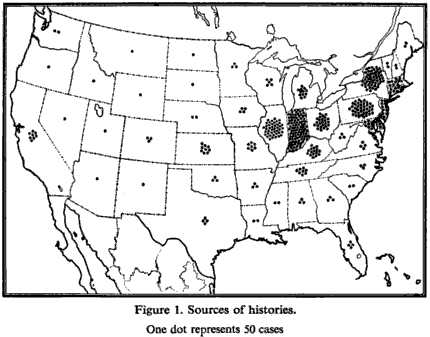 By working in this opportunistic fashion, the final sample pool ended up being quite large. But size alone doesn't guarantee accuracy in representing the U.S. population. One look at the demographics of Kinsey’s sample clearly showed its biases. Kinsey’s sample favored professionals and those under the age of 35. Geographically, Kinsey’s sample was heavily concentrated on the Northeast and Midwest, especially in the state of Indiana where the bulk of Kinsey’s surveys took place.17
By working in this opportunistic fashion, the final sample pool ended up being quite large. But size alone doesn't guarantee accuracy in representing the U.S. population. One look at the demographics of Kinsey’s sample clearly showed its biases. Kinsey’s sample favored professionals and those under the age of 35. Geographically, Kinsey’s sample was heavily concentrated on the Northeast and Midwest, especially in the state of Indiana where the bulk of Kinsey’s surveys took place.17
Kinsey’s homosexual sample provides another illustration of the problems in Kinsey’s dataset. Because of the difficulty in finding homosexuals in the repressive atmosphere the time, Dr. Kinsey relied on interviews with members of homophile groups such as the Mattachine Society and homosexual communities in a few large cities. He also interviewed prisoners and institutional populations. As a result, the homosexual sample ended up consisting of delinquent and non-delinquent sub-groups:18
| Non-Delinquent | Delinquent | |
|---|---|---|
| White Male | 782 | 946 |
| Nonwhite Male | 243 | 95 |
Male Subtotal |
1,025 | 1,041 |
| White Female | 84 | 260 |
| Nonwhite Female | 86 | 45 |
Female Subtotal |
170 | 305 |
The delinquent population made up almost half of the total gay male population, while the lesbian population is exceedingly small. Drawing conclusions on the sexual habits of gay men and lesbians is very problematic, especially when the numbers for the delinquent population are combined with the non-delinquent population.
Despite all of these many flaws, the data from the Kinsey Reports were the best data — and practically the only data — available on sexual behavior in the United States for more than 40 years. As Dr. Gagnon noted, the controversy surrounding the Kinsey Reports scared off potential funders of further sex research, and it was simply too much of a political hot potato for the federal government to do it. This would have serious consequences at the dawn of the AIDS crisis when researchers at the CDC had no choice but to rely on the highly inaccurate statistics from the Kinsey Reports to try to formulate future predictions of the emerging epidemic. While they felt that inaccurate statistics were at least better than working with no data at all, they were never able to get a handle on anticipating the progression and the direction of the epidemic.
In the late 1980’s, the National Institutes of Health responded to the pressing need for accurate data by funding the National Opinion Research Center (NORC) to conduct a wide-ranging, highly detailed, and (most importantly) statistically representative survey of Americans sexual behavior. But Senator Jesse Helms and Rep. William Dannemeyer, fearing that Kinsey’s findings on homosexuality might be replicated, pushed through legislation which effectively cancelled that study. So during the midst of a national health crisis, Helms and Dannemeyer made the unconscionable choice of ignorance over sound health policy by blocking the collection of data which would have played an important role in dealing with the HIV/AIDS crisis.
NORC was eventually able to revive a greatly downsized study using private funding, 19 and its more rigorous statistical methods were designed to be light-years ahead of the original Kinsey reports. The final NORC study resulted in a much more accurate picture of Americans’ overall sexual behavior, and this more accurate picture proved to be a generally more conservative one than Kinsey’s surveys suggested. But the downsizing of the NORC study was a lost opportunity in many important ways. Limited funding forced NORC to draw from a much smaller sample and to narrow the scope of their investigations to a smaller range of behaviors. These compromises meant that the accuracy would be poorer for smaller subpopulations (the homosexual and bisexual male populations, for example), and many important questions would have to go unasked and unanswered — the very problems the NIH wanted to correct in the first place. Consequently, even today we still have very little reliable data on American’s sexual behavior, and almost none which rivals the scale and breadth of what Kinsey set out to do.
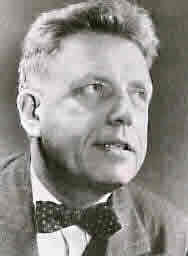 Kinsey’s statistical methodologies are certainly primitive by today’s standards. They would be considered unacceptable today for any serous scientific study — although many popular informal surveys with far worse methodologies continue to be published in the popular press (and are often cited by social conservatives as though they were accurate). But sixty years on, Kinsey’s achievement remains impressive. He not only undertook the very first wide-ranging survey of American attitudes about sexuality, he single-handedly pioneered the entire field of sex research and placed upon it the expectation of scientific rigor. That revolutionary step had never been done before, and our knowledge about sex hasn’t been the same since.
Kinsey’s statistical methodologies are certainly primitive by today’s standards. They would be considered unacceptable today for any serous scientific study — although many popular informal surveys with far worse methodologies continue to be published in the popular press (and are often cited by social conservatives as though they were accurate). But sixty years on, Kinsey’s achievement remains impressive. He not only undertook the very first wide-ranging survey of American attitudes about sexuality, he single-handedly pioneered the entire field of sex research and placed upon it the expectation of scientific rigor. That revolutionary step had never been done before, and our knowledge about sex hasn’t been the same since.
Notes:
1. Gagnon, John H. “Kinsey: Totem in the land of taboo.” Sexualities 1, no. 1 (February 1998): 91-94.
2. Kinsey, Alfred C.; Pomeroy, Wardell B.; Martin, Clyde E. Sexual Behavior In the Human Male (Philadelphia: W.B. Saunders: 1948): 499.
3. Kinsey, Alfred C.; Pomeroy, Wardell B.; Martin, Clyde E. Sexual Behavior In the Human Male (Philadelphia: W.B. Saunders: 1948): 576.
4. Kinsey, Alfred C.; Pomeroy, Wardell B.; Martin, Clyde E. Sexual Behavior In the Human Male (Philadelphia: W.B. Saunders: 1948): 142.
5. Kinsey, Alfred C.; Pomeroy, Wardell B.; Martin, Clyde E. Sexual Behavior In the Human Male (Philadelphia: W.B. Saunders: 1948): 392.
6. Kinsey, Alfred C.; Pomeroy, Wardell B.; Martin, Clyde E. Sexual Behavior In the Human Male (Philadelphia: W.B. Saunders: 1948): 650.
7. Kinsey, Alfred C.; Pomeroy, Wardell B.; Martin, Clyde E. Sexual Behavior In the Human Male (Philadelphia: W.B. Saunders: 1948): 650-651.
8. Kinsey, Alfred C.; Pomeroy, Wardell B,; Martin, Clyde E.; Gebhard, Paul H. Sexual Behavior In the Human Female (Philadelphia: W.B. Saunders: 1953): 499.
9. Kinsey, Alfred C.; Pomeroy, Wardell B,; Martin, Clyde E.; Gebhard, Paul H. Sexual Behavior In the Human Female (Philadelphia: W.B. Saunders: 1953): 488.
10. Folsom, Joseph K. “Kinsey’s challenge to ethics and religion.” Social Problems 1, no. 4 (April 1954): 164-168.
11. “How to stop gin rummy.” Time (March 1, 1948). Available online at http://www.time.com/time/magazine/article/0,9171,794270,00.html.
12. Human Events. “Ten Most Harmful Books of the 19th and 20th Centuries.” Web site (May 31, 2005; accessed December 29, 2007): http://www.humanevents.com/article.php?id=7591.
13. Gagnon, John H. “Kinsey: Totem in the land of taboo.” Sexualities 1, no. 1 (February 1998): 91-94.
14. Wallis, W. Allen. “Statistics of the Kinsey Report.” Journal of the American Statistical Association 44, no. 248 (December 1949): 463-484.
15. Gebhard, Paul.; Johnson, Alan. The Kinsey Data: Marginal Tabulations of the 1938-1963 Interviews Conducted by the Institute for Sex Research (New York: Saunders, 1979): 25.
16. Gebhard, Paul.; Johnson, Alan. The Kinsey Data: Marginal Tabulations of the 1938-1963 Interviews Conducted by the Institute for Sex Research (New York: Saunders, 1979): 25-27.
17. Kinsey, Alfred C.; Pomeroy, Wardell B.; Martin, Clyde E. Sexual Behavior In the Human Male (Philadelphia: W.B. Saunders: 1948): 5.
18. Gebhard, Paul.; Johnson, Alan. The Kinsey Data: Marginal Tabulations of the 1938-1963 Interviews Conducted by the Institute for Sex Research (New York: Saunders, 1979): 5.
19. The National Opinion Research Center (NORC) study was published in two volumes. The first one was for researchers, and the second was for the general public.
Laumann, Edward O.; Gagnon, John H.; Michael, Robert T.; Michaels, Stuart. The Social Organization of Sexuality: Sexual Practices In the United States (Chicago: University of Chicago Press, 1994).
Michael, Robert T.; Gagnon, John H.; Laumann, Edward O.; Kolata, Gina. Sex In America: A Definitive Study (Boston: Little, Brown & Co., 1994).
